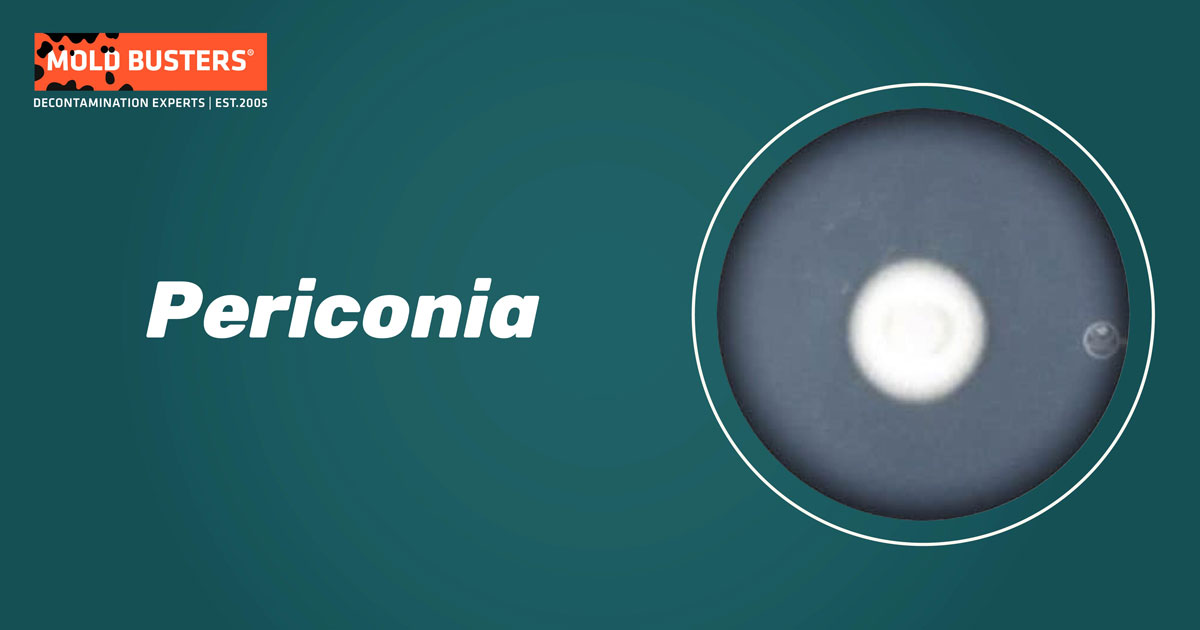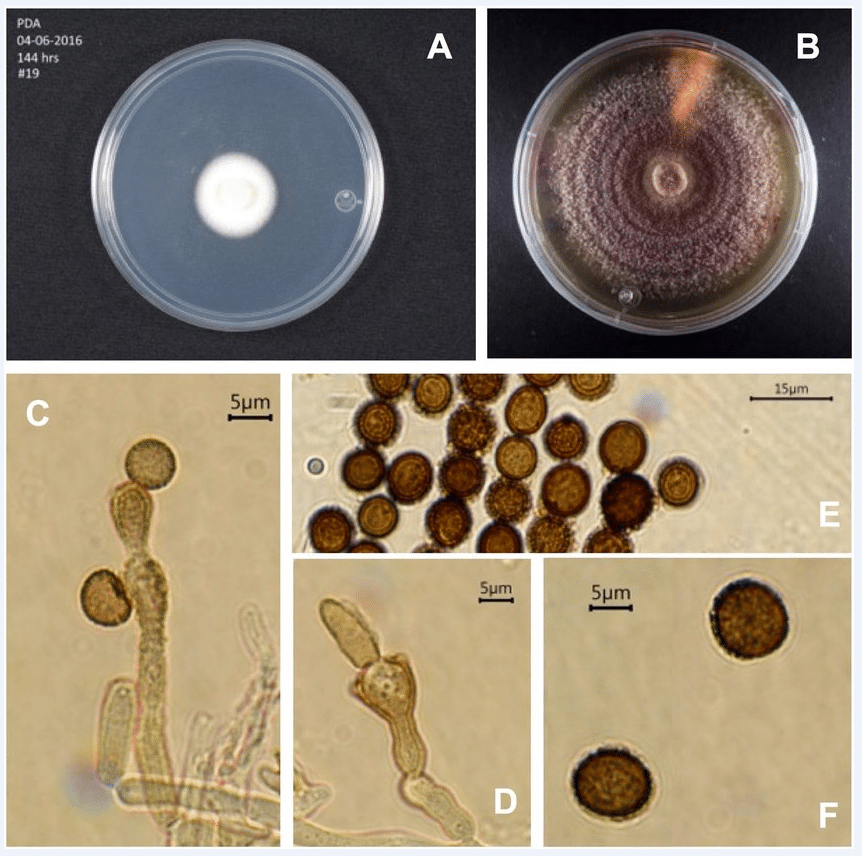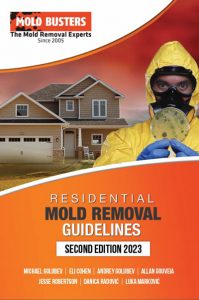What is Periconia?
Periconia is a genus of fungi that belongs to the order Pleosporales, class Dothideomycetes. The genus is widespread, containing species that are usually saprophytic [1] and specific plant pathogens or endophytes on herbaceous or woody plants [2,3].
Periconia species likes moderate and tropical climates, it could be usually found in terrestrial, and freshwater habitats, in tallgrass prairie, and semiarid grassland ecosystem, as well as in mangrove, marine, and hypersaline ecosystems[1-5]. Economically the most important species are Periconia circinata and P. macrospinosa [2].
Genus is anamorphic and polyphyletic, meaning species are reproduced only asexually and originate from a different ancestor. Species forms pale to dark brown conidia (spherical to ellipsoidal, smooth or ornamented) that are borne mostly on macronematous conidiophores (with or without branches) [2,3].

Periconia sp. produces fusicoccane diterpenes periconicin A and B and recently was found to produce periconin C and D [4,6]. The whole genome was sequenced for Periconia macrospinosa, and its length is 54.99 Megabase pairs (1Mb=1 million bp) [5].
Where can be Periconia be found?
Periconia spores are more commonly found outdoors and less indoors (incidence 1-5% of total spores indoors) [7,8]. Indoors could be found in a ventilation system, market and storage places, libraries, bedrooms [7,9,10], in dust, on papers and books [10,11]. There is no data of indoor damage by Periconia species, but it is causes deterioration of papers and books [11].
Periconia species
This genus was introduced is in 1791, when Tode described a type species called Periconia lichenoides. In the meantime, type specimen was lost, but according to its drawings, it resembles to P. byssoides or P. cookie. The database for the Periconia species is incomplete, without any ecological and morphological details, and lack of nucleotide information making their identification difficult [2,3]. The taxonomy of the Periconia spp. is changeable, and the total number of species varies in the literature from around 200 [12,13] to 40 species [14,15]. Frequently isolated species are Periconia circinata, P. macrospinosa, P. byssoides, P. cookie [2,3,16-18], and P. igniaria [5,16,19].

Periconia plant pathogenic species
Periconia circinata and P. macrospinosa are plant pathogens, causing various diseases of roots and leaves [2]. P. igniaria caused leaf spot on weedy plant- yellow starthistle (Centaurea solstitialis) [16], P. macrospinosa caused leaf necrosis of pointed gourd (Trichosanthes dioica) [17]. In contrast, P. circinata caused blackening and rotting of the roots and stem base of wheat [18].
Is Periconia dangerous?
Periconia spp. and Periconia atra caused human keratitis [20]. Periconia is known to be potentially allergenic [11], but a smaller amount of spores (0,63% of total spores per m3) were found in bedrooms of pulmonary hemorrhage patients [21]. Periconin B isolated from P. atropurpurea had potent cytotoxic activity, as decreased cell viability of human cervix carcinoma and Chinese hamster ovary (IC50=8.0 µM) [22].
Periconia benefits
Periconicin A isolated from endophytic fungus Periconia sp. exhibited an inhibitory effect on certain pathogens, including Candida albicans, Trichophyton mentagrophytes, T. rubrum, and Aspergillus niger [4,6]. In contrast, periconin B, C, and D exhibited moderate inhibitor activity against A. niger [6].
Species Periconia stamensis can inhibit the growth of human pathogens: Bacillus cereus, Lysteria monocytogenes, and Pseudomonas aeruginosa, thanks to its metabolites Modiolide A and 4-Chromanone-6-hidroxy-2-methyl-(5IC) [23].
Compound 2,4-dihydroxy-6-[(1´E,3´E)-penta-1´,3´-dienyl]-benzaldehyde isolated from P. atropurpurea had strong antifungal activity against Cladosporium sphaerospermum and C. cladosporioides [22]. Also, some interesting fact is that Periconia sp. isolated from a host long pepper (Piper longum L.) produced piperine, which is the first report that it could be synthesized by the fungus, not just by the pepper itself. This fungus-derived piperine had strong antimycobacterial activity against Mycobacterium tuberculosis and M. smegmetis [24].
Similarly, Periconia sp. isolated from tree Torreya grandifolia produced taxol known as an anticancer compound [25]. It is uncertain if chemical production occurs due to interaction between microbes, but some members of this genus have the potential for novel pharmaceutical products [24].

Did you know?
Only 12% of tested indoor air quality samples in Canada didn’t have any presence of mold! Find out more exciting mold stats and facts on our mold statistics page.
References
- Cantrell SA, Hanlin RT, Emiliano A.(2007). Periconia variicolor nov., a New Species from Puerto Rico. Mycologia, 99(3):482-487.
- Markovskaja S, Kačergius A (2014). Morphological and molecular characterisation of Periconia pseudobyssoides nov. and closely related P. byssoides. Mycological Progress,13: 291–302.
- Chuaseeharonnachai C, Somrithipol S, Boonyuen N (2016). Periconia notabilis nov. and a new record and notes on the genus in Thailand. Mycotaxon, 131:491–502.
- Dong-Sun S, Oh M-N, Yang, H-C, Oh K-B (2005). Biological characterization of Periconicins, Bioactive Secondary Metabolites produced by Periconia OBW-15. J. Microbiol. Biotechnol, 15(1): 216-220.
- Knapp DG, Nemeth JB, Barry K, Hainaut M, Henrissat B, Johnson J, Kuo A, Hui Ping Lim J, Lipzen A, Nolan M, Ohm RA, Tamas L, Grigoriev IV, Spatafora JW, Nagy LG, Kovacs GM (2018). Comparative genomics provides insights into the lifestyle and reveals functional heterogeneity of dark septate endophytic fungi. Scientific Reports, 8: 6321
- Wu Y-H, Xiao G-K, Chen G-D, Wang C-X, Hu D, Lian Y-Y, Lin F, Guo L-D, Yao X-S, Gao H (2015). Pericocins A–D, New Bioactive Compounds from Periconia Natural Product Communications, 10 (12): 2127-2130.
- Rojas TI, Jesus Aira M (2012). Fungal biodiversity in indoor environments in Havana, Cuba. Aerobiologia, 28:367–374
- Patil BY, Chavre BW (2012). Survey of indoor airspora in Kallam tehsil of Osmanabad District, Maharashtra, India. Indian J. Applied & Pure Bio., 27(1):65-69.
- Bhattacharya K, Raha S, Majumdar MR (2001). Fungal Contaminants in Rural West Bengal, India, with Reference to Allergy Symptoms. Indoor Built Environment, 10:40-47.
- Sanchez Espinosa KC, Rojas Flores TI, Rodríguez Davydenko S, Venero Fernández SJ, Almaguer M. (2021). Fungal populations in the bedroom dust of children in Havana, Cuba, and its relationship with environmental conditions. Environmental Science and Pollution Research. doi.org.
- Tilak ST (1991). Aeromycology: Aspects and Prospects. Fungi and Biotechnology, Recent Advances, pp. 765-768.
- Retrived from indexfungorum.org
- Retrived from mycobank.org
- Seifert KA, Games W (2011). The genera of Hyphomycetes-2011 update. Persoonia, 27(1):119-29.
- Retrived from ncbi.nlm.nih.gov
- Kolomiets T, Pankratova L, Mukhina Z, Kassanelly D, Matveeva T, Bogomaz D, Berner D (2008). First Report of Leaf Spot Caused by Periconia igniaria on Yellow Starthistle in Russia. Plant Disease, 92(6):983.
- Sarkar T, Chakraborty P, Karmakar A, Saha A, Saha D (2019). First report of Periconia macrospinosa causing leaf necrosisof pointed gourd in India. Journal of Plant Pathology, 101:1281.
- Goga, N (2000). Periconia circinata – a new pathogen of roots and stem base of wheat in northwestern Romania. Analele Institutului de Cercetări pentru Cereale și Plante Tehnice, Fundulea, 67:205-214.
- Wu H, Yan Z, Deng Y, Wu Z, Xu X, Li X, Zhou X, Luo H (2020). Endophytic fungi from the root tubers of medicinal plant Stephania dielsiana and their antimicrobial activity. Acta Ecologica Sinica, 40 (5): 383-387.
- Gunasekaran R, Janakiraman D, Karthikeyan Rajapandian SG, Pandiyan Appavu S, Namperumalsamy Venkatesh P, Prajna L (2021). Periconia species – An unusual fungal pathogen causing mycotic keratitis. Indian Journal of Medical Microbiology, 39: 36–40.
- Flappan SM, Portnoy J, Jones P, Barnes C (1999). Infant Pulmonary Hemorrhage in a Suburban Home with Water Damage and Mold (Stachybotrys atra). Grand Rounds in Environmental Medicine, 107 (11):927-930.
- Lopes Teles H, Sordi R, Humberto Silva S, Castro-Gamboa I, da Silva Bolzani V, Pfenning LH, Magalhaes de Abreu L, Costa-Neto CM, Marx Young MC, Araujo AR (2006). Aromatic compounds produced by Periconia atropurpurea, an endophytic fungus associated with Xylopia aromatica. Phytochemistry 67: 2686–2690.
- Bhilabutra W, Peberdy JF (2007). Antimicrobial Activity of Bioactive Compounds from Periconia siamensis CMUGE015. Research Journal of Microbiology, 2(10):749-755.
- Verma VC, Lobkovsky E, Gange AC, Singh SK, Prakash S (2011). Piperine production by endophytic fungus Periconia isolated from Piper longum L. The Journal of Antibiotics, 64: 427–431.
- Li JY, Sidhu RS, Ford EJ, Long DM, Hess WM, Strobel GA (1998). The induction of taxol production in the endophytic fungus—Periconia sp from Torreya grandifolia. Journal of Industrial Microbiology and Biotechnology, 20: 259–264.

Get Special Gift: Industry-Standard Mold Removal Guidelines
Download the industry-standard guidelines that Mold Busters use in their own mold removal services, including news, tips and special offers:

Written by:
Aleksandra Zebeljan
Mycologist
Mold Busters
Edited by:
Dusan Sadikovic
Mycologist – MSc, PhD
Mold Busters
